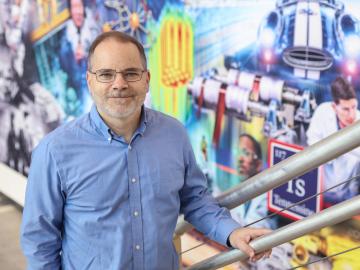
Filter News
Area of Research
- (-) Computational Engineering (2)
- (-) Energy Science (109)
- (-) Fusion and Fission (30)
- Advanced Manufacturing (3)
- Biological Systems (2)
- Biology and Environment (137)
- Biology and Soft Matter (1)
- Computational Biology (1)
- Computer Science (7)
- Electricity and Smart Grid (1)
- Functional Materials for Energy (1)
- Fusion Energy (17)
- Isotopes (2)
- Materials (59)
- Materials for Computing (10)
- Mathematics (1)
- National Security (26)
- Neutron Science (30)
- Nuclear Science and Technology (20)
- Nuclear Systems Modeling, Simulation and Validation (1)
- Quantum information Science (1)
- Sensors and Controls (1)
- Supercomputing (78)
News Topics
- (-) Advanced Reactors (9)
- (-) Artificial Intelligence (10)
- (-) Bioenergy (26)
- (-) Coronavirus (12)
- (-) Environment (55)
- (-) Fusion (22)
- (-) Polymers (11)
- (-) Security (7)
- 3-D Printing/Advanced Manufacturing (79)
- Big Data (6)
- Biology (12)
- Biomedical (8)
- Biotechnology (4)
- Buildings (38)
- Chemical Sciences (17)
- Clean Water (8)
- Composites (17)
- Computer Science (28)
- Critical Materials (10)
- Cybersecurity (8)
- Education (1)
- Energy Storage (72)
- Exascale Computing (3)
- Fossil Energy (2)
- Frontier (3)
- Grid (39)
- High-Performance Computing (8)
- Hydropower (3)
- Isotopes (2)
- ITER (6)
- Machine Learning (8)
- Materials (36)
- Materials Science (29)
- Mathematics (2)
- Mercury (3)
- Microelectronics (1)
- Microscopy (9)
- Molten Salt (1)
- Nanotechnology (9)
- National Security (5)
- Neutron Science (12)
- Nuclear Energy (30)
- Partnerships (13)
- Physics (2)
- Quantum Science (2)
- Simulation (7)
- Space Exploration (4)
- Statistics (1)
- Summit (5)
- Transportation (67)
Media Contacts

Staff at Oak Ridge National Laboratory organized transport for a powerful component that is critical to the world’s largest experiment, the international ITER project.

Diego Del-Castillo-Negrete, a distinguished staff member in the Fusion Energy Division, was cited for Outstanding Technical Achievement – National Laboratory. He will be recognized during the GMiS annual conference, which will be held virtually Oct. 11-22. The HENAAC awards program is in its 33rd year.

Nearly a billion acres of land in the United States is dedicated to agriculture, producing more than a trillion dollars of food products to feed the country and the world. Those same agricultural processes, however, also produced an estimated 700 million metric tons of carbon dioxide equivalent in 2018, according to the U.S. Department of Agriculture.

Improved data, models and analyses from ORNL scientists and many other researchers in the latest global climate assessment report provide new levels of certainty about what the future holds for the planet

Four first-of-a-kind 3D-printed fuel assembly brackets, produced at the Department of Energy’s Manufacturing Demonstration Facility at Oak Ridge National Laboratory, have been installed and are now under routine operating

Joseph Pickel has been elected a 2021 fellow of the American Chemical Society, or ACS. Pickel supports the Fusion and Fission Energy and Sciences Directorate as environment, safety and health

David Sholl is director of the new ORNL Transformational Decarbonization Initiative, working to elevate the lab’s prominence in decarbonization science and technology. Credit: Genevieve Martin, ORNL/U.S. Dept. of Energy.

Equipment and expertise from Oak Ridge National Laboratory will allow scientists studying fusion energy and technologies to acquire crucial data during landmark fusion experiments in Europe.

Kathy McCarthy, associate laboratory director for Fusion and Fission Energy and Science at the Department of Energy’s Oak Ridge National Laboratory, has been elected fellow of the American Nuclear Society for her nationally and internationally recognized leadership in nuclear energy and fusion.

ORNL’s Zhenglong Li led a team tasked with improving the current technique for converting ethanol to C3+ olefins and demonstrated a unique composite catalyst that upends current practice and drives down costs. The research was published in ACS Catalysis.


